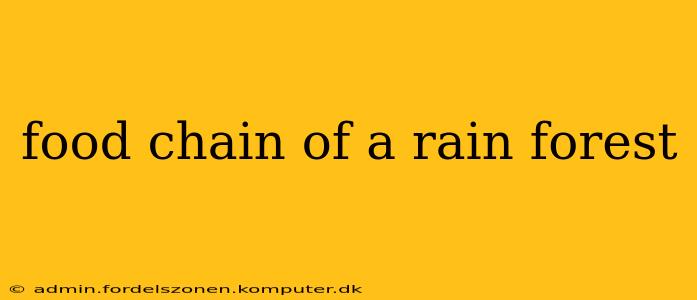Rainforests, the Earth's most biodiverse ecosystems, boast incredibly complex food chains. Understanding these intricate webs is crucial to appreciating the delicate balance of these vital environments. This article explores the rainforest food chain, examining its various levels and the interconnectedness of its inhabitants. We'll also delve into frequently asked questions about this fascinating topic.
What are the different trophic levels in a rainforest food chain?
The rainforest food chain, like any other, is organized into trophic levels representing the feeding relationships between organisms. These levels typically include:
-
Producers (Trophic Level 1): These are the foundation of the food chain, primarily plants. In rainforests, this includes a vast array of trees, shrubs, vines, epiphytes (plants that grow on other plants), and other photosynthetic organisms. They convert sunlight into energy through photosynthesis, forming the base of the entire food web.
-
Primary Consumers (Trophic Level 2): Herbivores, or plant-eaters, make up this level. This diverse group includes insects like butterflies and beetles, various species of birds, mammals such as sloths and monkeys, and reptiles like iguanas. They directly consume the producers.
-
Secondary Consumers (Trophic Level 3): These are carnivores (meat-eaters) that prey on primary consumers. Examples include snakes, frogs, lizards, smaller felines, and some birds of prey. They gain energy by consuming herbivores.
-
Tertiary Consumers (Trophic Level 4): At the top of the food chain are the apex predators, often large carnivores that feed on secondary consumers. In rainforests, this might include jaguars, eagles, or large snakes. They are at the top of their particular food chain, though they are still subject to natural mortality.
-
Decomposers: These vital organisms, including fungi and bacteria, break down dead plants and animals, returning essential nutrients to the soil. This process is critical for the continued health and productivity of the rainforest ecosystem. They are present at every level, recycling materials back to the producers.
What are some examples of rainforest food chains?
Instead of a single, linear chain, rainforests possess multiple interconnected food webs. Here are a few examples illustrating the flow of energy:
-
Example 1: Leaf (Producer) → Caterpillar (Primary Consumer) → Bird (Secondary Consumer) → Snake (Tertiary Consumer)
-
Example 2: Fruit (Producer) → Monkey (Primary Consumer) → Jaguar (Tertiary Consumer)
-
Example 3: Flowers (Producer) → Hummingbird (Primary Consumer) → Hawk (Secondary Consumer)
How does the rainforest food web maintain balance?
The rainforest's food web is a complex and dynamic system. Balance is maintained through a variety of factors:
-
Predator-Prey Relationships: The interactions between predators and their prey regulate population sizes, preventing any single species from becoming overwhelmingly dominant.
-
Competition: Competition for resources, such as food and habitat, ensures that no single species monopolizes the available resources.
-
Symbiotic Relationships: Many species engage in symbiotic relationships, such as mutualism (both species benefit) or commensalism (one species benefits, the other is unaffected). These relationships contribute to the overall stability of the ecosystem.
-
Environmental Factors: Rainfall, temperature, and other environmental factors also influence the balance of the rainforest food web.
What is the role of decomposers in the rainforest food chain?
Decomposers play a crucial role in the rainforest's nutrient cycle. By breaking down dead organic matter (plants and animals), they release essential nutrients back into the soil. These nutrients are then absorbed by plants, restarting the food chain. Without decomposers, the rainforest would be choked with dead matter, and vital nutrients would be unavailable for new growth.
How does deforestation affect the rainforest food chain?
Deforestation has devastating effects on the rainforest food chain. Habitat loss directly impacts many species, disrupting predator-prey relationships and causing population declines. The removal of trees also disrupts the nutrient cycle, affecting the producers and ultimately the entire food web. This leads to a loss of biodiversity and ecosystem instability.
Conclusion:
The rainforest food chain is a remarkable tapestry of interconnected life, showcasing the intricate relationships between organisms at various trophic levels. Understanding this complexity highlights the fragility of these ecosystems and the importance of conservation efforts to protect these vital habitats and their unique inhabitants. The intricate web of life in the rainforest is a testament to the beauty and complexity of nature.
